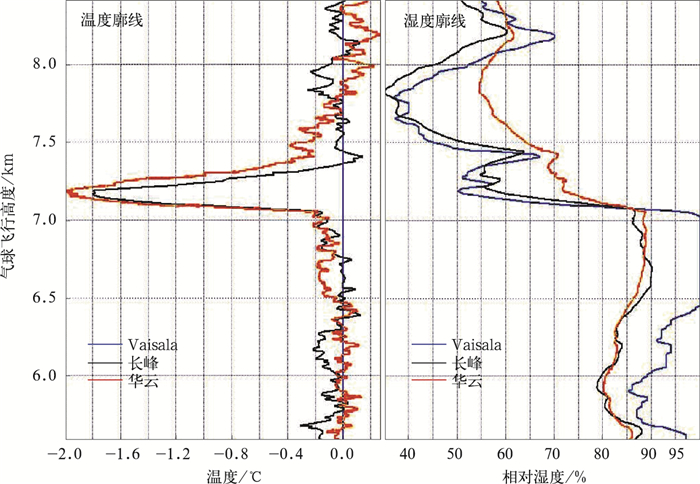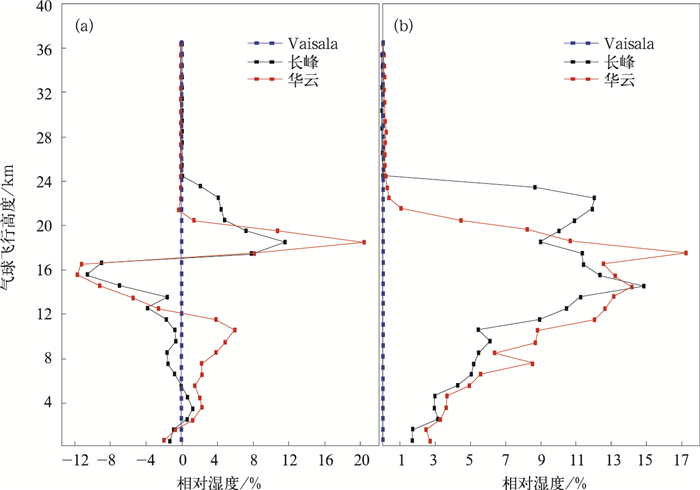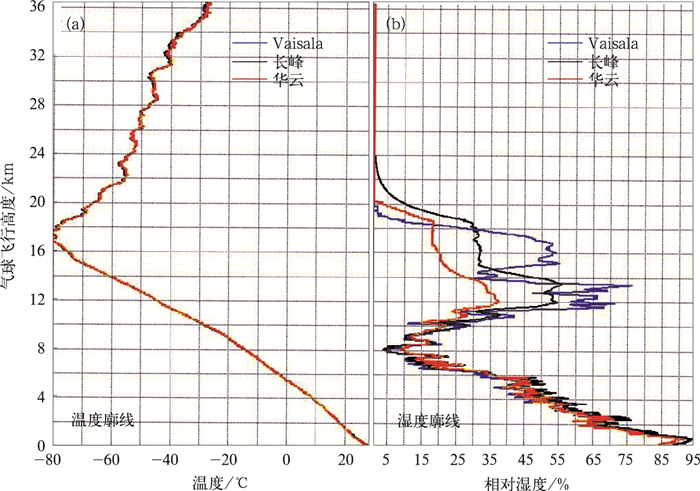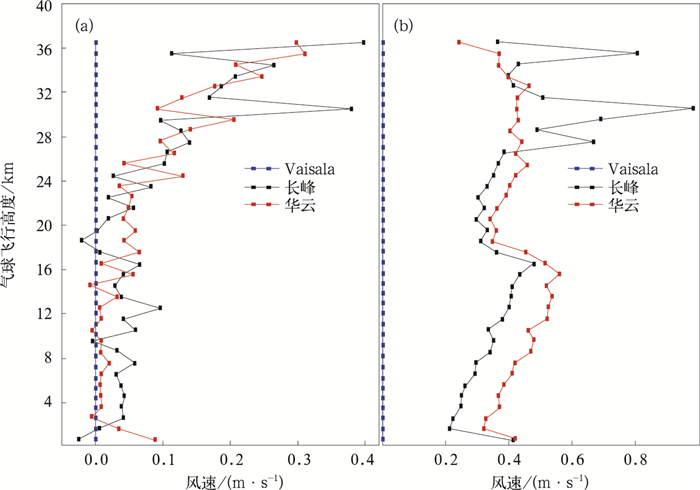The International Radiosonde Intercomparison Result for China-made GPS Radiosonde
-
摘要: 通过2010年7月12日—8月1日第8届世界气象组织阳江国际探空比对,采取同球比对施放方式,选择芬兰Vaisala探空仪作为比对标准,对中国参加国际比对的长峰探空仪与华云探空仪,使用共29次同球比对数据,从典型个例分析与统计分析两方面开展系统性评估。初步评估结果表明:对于温度探测,中国长峰探空仪整体系统偏差在0.4℃之内,标准偏差在0.7℃之内,中国华云探空仪在30 km高度以下性能与长峰探空仪相当,但是30 km高度以上偏差明显增大;对于气压与风的探测,两者系统偏差与标准偏差均较小,表明GPS定位以及气压与风的算法准确;对于湿度探测,与芬兰Vaisala探空仪相比,还存在一定差距,特别是低温性能需要提高。Abstract: Based on total 29 groups observation data of the 8th WMO International Radionsonde System Intercomparison, using the same balloon releasing method and mainly choosing Vaisala radiosonde measurements as relative reference standard, the systematic evaluation for Changfeng China-made GPS radiosonde system and Huayun China-made GPS radiosonde system is carried out including typical examples analysis and statistics analysis. The initial evaluation results show that for temperature observation, the value of both domestic radiosonde is higher compared to Vaisala radiosonde. The relative systematic error of Changfeng radiosonde is within 0.4℃ and standard deviation is within 0.7℃, the Huayun radiosonde owns similar performance, but its error obviously increases. For humidity observation, the observation data of Changfeng radiosonde below 16 km basically show dry trend compared to Vaisala radiosonde, and below 12 km humid trend for Huayun radiosonde. Below 14 km the relative systematic errors for Changfeng radiosonde and Huayun radiosonde can be within 4% and 6%, respectively, and above 14 km the relative systematic errors obviously increase, reaching 12% and 20%, respectively, and the standard deviations for gradually show increasing trend from surface to tropopause and can reach 14% and 17%, respectively. For pressure observation the relative systematic errors and standard deviations for Changfeng radiosonde and Huayun radiosonde is smaller compared to Vaisala radiosonde, the relative systematic errors show the similar trend that negative values occur in low layer and positive values in upper layer, and the standard deviations show decreasing trend from surface to upper layer. The absolute value of minimal relative systematic error minus maximal relative systematic error is within 1 hPa and maximal standard deviation is 1.2 hPa for surface point, assuring the accurate geopotential height calculation and correct pressure retrieving algorithm. For wind observation the relative systematic errors and standard deviations for Changfeng radiosonde and Huayun radiosonde is smaller compared to Vaisala radiosonde, and the analysis results show excellent GPS positioning function and correct wind calculation algorithm. It can be concluded the domestic radiosonde has reached advanced level except for the humidity element. In future, more improvements should be made on temperature observation above 30 km and humidity observation under low temperature.
-
表 1 各高度层温度统计样本数
Table 1 The temperature sample amount at different heights
分析高度/km Vaisala 长峰 华云 2 6196 6195 6196 4 6035 6035 6035 6 5673 5673 5673 8 5413 5413 5413 10 5274 5274 5274 12 5058 5058 5058 14 4959 4959 4959 16 4660 4660 4660 18 5278 5278 5278 20 6317 6317 6317 22 5303 5303 5303 24 4684 6683 4683 26 4050 4050 4048 28 3643 3387 3435 30 3570 3290 3179 32 3302 3215 2970 34 3132 3132 2508 36 1891 1891 1117 38 280 280 40 表 2 各高度层湿度统计样本数
Table 2 The humidity sample amount at different heights
分析高度/km Vaisala 长峰 华云 2 5850 5849 5850 4 5700 5700 5700 6 5352 5352 5352 8 5114 5114 5114 10 4072 4072 4072 12 4775 4775 4775 14 4862 4862 4862 16 4366 4366 4366 18 4990 4990 4990 20 5976 5976 5976 22 4956 4956 4956 24 4380 4379 4379 26 3770 3770 3768 28 3374 3118 3374 30 3202 3002 3202 32 2000 2934 2000 34 3240 3240 3240 36 1877 1877 1877 38 240 240 240 表 3 各高度层气压统计样本数
Table 3 The pressure sample amount at different heights
分析高度/km Vaisala 长峰 华云 2 6196 6195 6196 4 6035 6035 6035 6 5873 5873 5873 8 5413 5413 5413 10 5274 5274 5274 12 5058 5058 5058 14 4059 4059 4059 16 4660 4660 4660 18 5278 5278 5278 20 6317 6317 6317 22 5303 5303 5303 24 4684 4683 4683 26 4050 4050 4048 28 3643 3388 3643 30 3570 3290 3570 32 3302 3246 3302 34 3514 3514 3514 36 2203 2203 2203 38 280 280 280 表 4 各高度层风统计样本数
Table 4 The wind sample amount at different heights
分析高度/km Vaisala 长峰 华云 2 6196 6195 6196 4 6035 6035 6035 6 5873 5873 5873 8 5413 5413 5413 10 5274 5274 5274 12 5058 5058 5058 14 4059 4059 4059 16 4660 4660 4660 18 5278 5278 5278 20 6317 6317 6317 22 5303 5303 5303 24 4684 4683 4683 26 4050 4050 4048 28 3643 3388 3643 30 3570 3570 3570 32 3302 3302 3302 34 3514 3514 3514 36 2203 2203 2203 38 280 280 280 -
[1] 宋连春, 李伟.综合气象观测系统的发展.气象, 2008, 34(3):3-9. doi: 10.7519/j.issn.1000-0526.2008.03.001 [2] WMO. Guide to Meteorological Instruments and Methods of Observation (Ⅴ7.0).Geneva:WMO, 2006. [3] Hooper A H. WMO International Radiosonde Comparison, Phase Ⅰ, Beaufort Park, U.K., 1984. WMO/TD-No.174, Instruments and Observing Methods Report No.28. Geneva:WMO, 1986. [4] Schmidlin F J. WMO International Radiosonde Comparison, Phase Ⅱ, Wallops Island, USA, 1985. WMO/TD-No.312, Instruments and Observing Methods Report No.29. Geneva:WMO, 1988. [5] Nash J, Schmidlin F J. WMO International Radiosonde Comparison, (U.K., 1984, U.S.A., 1985) Final Report. WMO/TD-No.195, Instruments and Observing Methods Report No.30. Geneva:WMO, 1987. [6] Ivanov A, Kats A, Kumosenko S, et al. WMO International Radiosonde Intercomparison Phase Ⅲ (Dzhambul, USSR, 1989) Final Report. WMO/TD-No.451, Instruments and Observing Methods Report No.40. Geneva:WMO, 1991. [7] Yagi S, Mita A, Inoue N. WMO International Radiosonde Intercomparison Phase Ⅳ (Tsukuba, Japan, 1993) Final Report. WMO/TD-No.742, Instruments and Observing Methods Report No.59. Geneva:WMO, 1996. [8] Balagurov A, Kats A, Krestyannikova N, et al. WMO Radiosonde Humidity Sensor Intercomparison, 1995. WMO/TD-No. 1305, Instruments and Observing Methods Report No.88. Geneva:WMO, 2006. [9] Da Silveira, Fisch R G, Machado L, et al. WMO Intercomparison of GPS Radiosondes, Alcantara, Brazil, 2001. WMO/TD-No.1314, Instruments and Observing Methods Report No.90. Geneva:WMO, 2006. [10] Nash J, Smout R, Oakley T, et al. WMO Intercomparison of High Quality Radiosonde Systems Final Report (Vacaos, Mauritius, 2005), Geneva:WMO, 2006. [11] GCOS. 2002: Manual on the GCOS Surface and Upper-Air Networks: GSN and GUAN, GCOS73. WMO/TD-No.1106, Geneva:WMO, 2002. [12] GCOS. 2007: GCOS Reference Upper-Air Network (GRUAN): Justification, Requirements, Siting and Instrumentation Options, GCOS112. WMO/TD-No.1379, Geneva:WMO, 2007. [13] Haimberger L. Homogenization of radiosonde temperature time series using innovation statistics. J Climate, 2007, 20(7):1377-1403. doi: 10.1175/JCLI4050.1 [14] Sapucci Luiz F, Luiz A T Machado, Reinaldo B, et al. Analysis of relative humidity sensors at the WMO radiosonde intercomparison experiment in Brazil. J Atmos Ocean Technol, 2005, 22(6):664-678. doi: 10.1175/JTECH1754.1 [15] 姚雯, 郑国光, 郭亚田, 等.气象探空测风软件系统的标准化研究.应用气象学报, 2004, 15(1):88-94. http://qikan.camscma.cn/jams/ch/reader/view_abstract.aspx?file_no=20040112&flag=1 [16] 黄炳勋.C波段测风一次雷达的跟踪特性及其应用前景.应用气象学报, 1995, 6(2):153-162. http://qikan.camscma.cn/jams/ch/reader/view_abstract.aspx?file_no=19950220&flag=1 [17] 姚雯, 马颖, 黄炳勋, 等.利用GPS定位资料分析L波段雷达测风性能.应用气象学报, 2009, 20(2):195-202. http://qikan.camscma.cn/jams/ch/reader/view_abstract.aspx?file_no=20090209&flag=1 [18] 毛节泰. GPS的气象应用.气象科技, 1993, 21(4):45-49. http://www.cnki.com.cn/Article/CJFDTOTAL-QUDW201104022.htm [19] 朱喜林.GPS及其在大气探测中的应用.气象水文海洋仪器, 2004(1):42-46. http://www.cnki.com.cn/Article/CJFDTOTAL-QXSW200401009.htm [20] 李国平, 黄丁发. GPS气象学研究及应用的进展与前景.气象科学, 2005, 25(6):651-661. http://www.cnki.com.cn/Article/CJFDTOTAL-QXKX200506012.htm [21] 秦晓军. GPS技术在气象探空测风中的应用.陕西气象, 2006(3):29-30. http://www.cnki.com.cn/Article/CJFDTOTAL-SXQI200603010.htm [22] 徐刚, 王培延. GPS气象探空仪原理与工程设计.导航, 2005, 41(2):115-118. http://cdmd.cnki.com.cn/Article/CDMD-10730-1015519400.htm [23] 马舒庆, 李峰, 邢毅.从毛里求斯国际探空系统对比看全球探空技术的发展.气象科技, 2006, 34(5):606-609. http://www.cnki.com.cn/Article/CJFDTOTAL-QXKJ200605022.htm [24] 李伟, 邢毅, 马舒庆.国产GTS1探空仪与VAISALA公司RS92探空仪对比分析.气象, 2009, 35(10):97-102. doi: 10.7519/j.issn.1000-0526.2009.10.012 [25] Jauhiainen H, Lehmuskero M. Vaisala White Paper, Performance of the Vaisala Radiosonde RS92-SGP and Vaisala DigiCORAR® Sounding System MW31 in the WMO Mauritius Radiosonde Intercomparison, 2005. [26] 李伟, 房岩松, 王缅.芬兰VAISALA公司RS92探空仪测量结果不确定度分析.仪器仪表学报, 2009, 30(6):89-91. http://cpfd.cnki.com.cn/Article/CPFDTOTAL-YQYB200907001032.htm -


 设为首页
设为首页 加入收藏
加入收藏


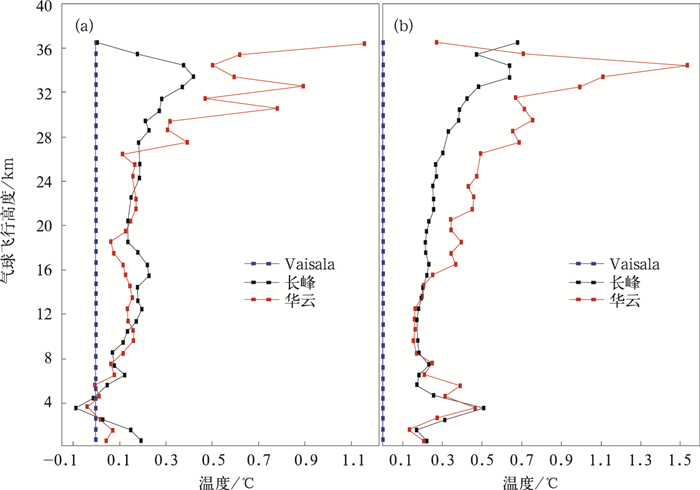
 下载:
下载:
